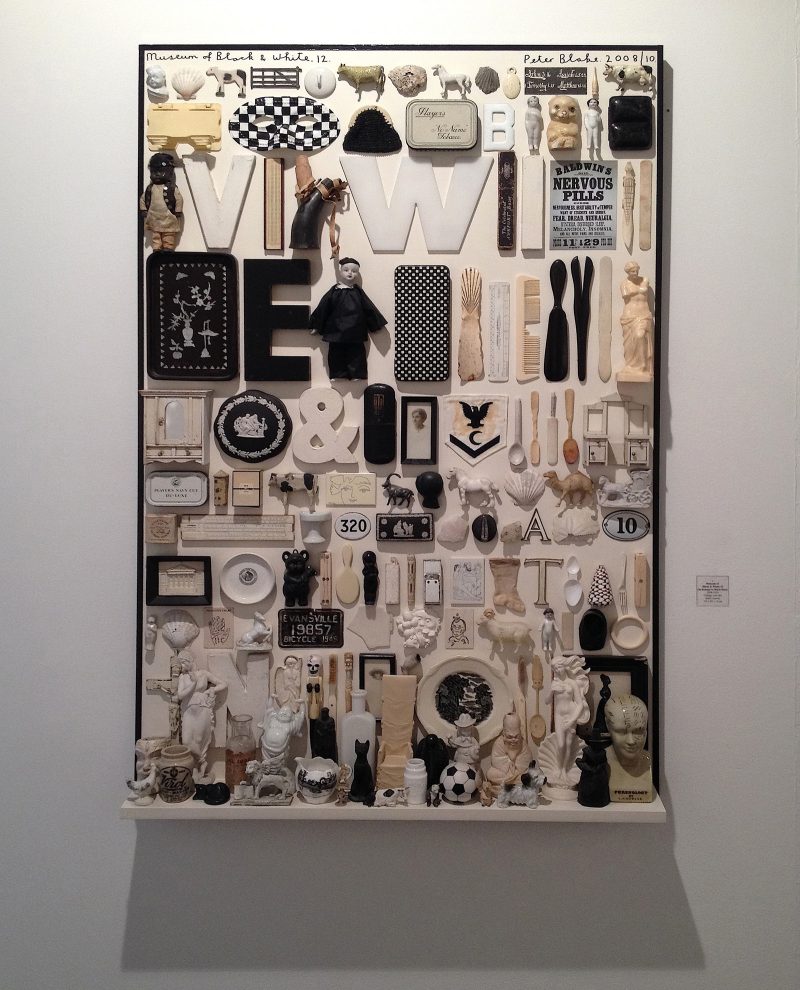
As the FIAC (Foire Internationale d’Art Contemporain) and a fistful of art fairs coursed through Paris in October like drunken sailors, some venues went full tilt on one-person exhibitions. Among them, Galerie Claude Bernard offered a sweet retrospective of the assemblage and painted works of British blue chipper Sir Peter Blake.
Blake, now 84, filled the Left Bank gallery with homages to some of his friends (and favorite artists) in beguiling pieces rife with erudition and humor. One of earliest practitioners of Pop, the artist began as a realist painter and moved sideways into emblematic, flatly rendered subjects like his “The First Real Target” (1961), a direct reference to Johns’ “Target” (1958). Blake, however, bought a real archery target and essentially collaged it onto canvas; it was not exactly a painting, but was suddenly in the context of one, and then viewed through filter of the Johns’ work.
Blake’s talent as assembler of ideas, draughtsman, painter, and maker of objects is formidable. He’ll screen print soft-porn French post cards, produce sensitive (and ironic) portraits of friends like David Hockney, erect large-scale cigar box soldiers. Blake became a global phenomenon with his design for The Beatles’ 1967 Sargent Pepper’s Lonely Hearts Club Band album cover. He was knighted by Queen Elizabeth, too, but Blake seemed always less interested in The Queen (or The King–Elvis) than their images.
The artist mined popular culture in a way few others have, and in fact, in a conversation with Lawrence Alloway helped name the movement–Pop Art–back in London in 1958. He’s persnickety about fonts, and from what I can only believe–his particular hoarding instincts. Which brings us back to the Claude Bernard exhibition: Blake is a serial multiplier. He makes not one or three images of a subject but dozens. He collects, organizes, labels. He’s fond of alphabets and artists–see his “Marcel Duchamp’s World Tour: Playing Chess with Tracey Emin” (2003-2005) or his “Butterfly” homage to Damien Hirst.
In the Paris show, with so many works on view, it was hard to choose one work that summed up Blake’s exhaustiveness, but perhaps his “Museum of Black & White 12” (in homage to Mark Dion), 2008-2010, offers a choice view of his oeuvre. The piece catalogs dozens of black and white objects–combs, spoons, numbers, letters, toy camels, horses, buddhas, and knick knacks affixed to a canvas and a shelf in typical Mark Dion fashion. Dion, an American conceptual artist, is known for his literal archeological digs and museum-like presentations of his finds. Blake reminds us of the artist’s métier with his wide-ranging endeavors–that the work is lifelong, the endeavor is serious and results are surprising reflections of what we’ve buried in our lives, our homes and our collective unconscious.
Peter Blake, 14 October – 26 November 2016, Galerie Claude Bernard, 5-7 Rue des Beaux Arts 75006 Paris, France.









